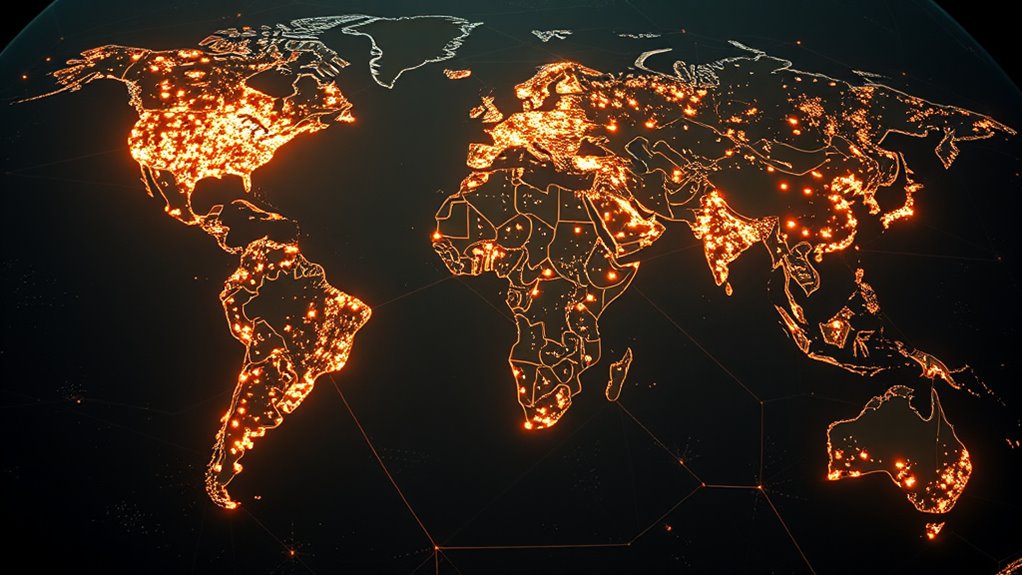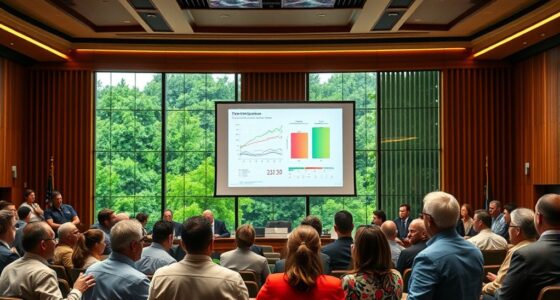You’ll notice that wealthier nations contribute more to international climate finance through grants, loans, and innovative tools like green bonds. Meanwhile, developing countries often struggle to secure enough support to implement adaptation measures, falling short of commitments. This funding gap impacts vulnerable populations most. If you look further, you’ll explore how global efforts aim to bridge this divide, ensuring everyone plays a part in fighting climate change and protecting our future.
Key Takeaways
- Wealthier nations generally contribute more to international climate finance than developing countries.
- Developed countries often do not meet their financial commitments under global climate agreements.
- Developing nations rely heavily on external funding sources like grants, loans, and green bonds.
- International climate finance aims to bridge the resource gap between rich and poor countries.
- Challenges include unequal contributions, lack of transparency, and ensuring funds benefit vulnerable populations.

Have you ever wondered how countries fund efforts to combat climate change across the globe? It’s a complex web of finance, with some nations stepping up more than others. One of the key ways to finance climate initiatives is through climate adaptation projects—those that help communities adjust to the changing climate and reduce vulnerabilities. When you think about the costs involved, it’s clear that funding isn’t evenly distributed. Wealthier nations often have more resources to invest, but many developing countries face significant barriers, making it harder for them to implement necessary measures. That’s where international climate finance comes into play, aiming to bridge this gap.
Green bonds are a popular tool used by governments and private entities to raise funds specifically for environmental projects. When you buy a green bond, you’re fundamentally investing in sustainable infrastructure or climate resilience programs. These bonds are attractive because they offer a way to channel private capital into climate adaptation initiatives, ensuring that projects like flood defenses, renewable energy installations, or sustainable agriculture can move forward. The funds raised through green bonds are often directed toward projects that help vulnerable populations cope with climate impacts, making them a crucial part of international climate finance strategies.
Green bonds channel private capital into climate resilience and sustainable infrastructure projects worldwide.
However, not all countries contribute equally. While some are actively issuing green bonds and investing heavily in climate adaptation, others either lack the capacity or the political will to do so. Many developing nations depend heavily on external funding, such as grants or loans from international organizations and developed countries. Unfortunately, commitments made in global climate agreements don’t always translate into concrete financial support. Often, you find that developed nations fall short of their promised contributions, leaving less money for adaptation projects in the most vulnerable regions. This disparity underscores the importance of accountability and transparency in international climate finance.
You should also recognize that climate finance isn’t just about providing money; it involves strategic planning, technical assistance, and knowledge transfer. When countries invest in climate adaptation, they’re not only protecting their citizens but also creating opportunities for sustainable development. These investments can lead to job creation, improved health outcomes, and increased resilience against climate shocks. Moreover, innovative financial tools like green bonds are expanding the options available to fund these crucial projects. Yet, the challenge remains: who’s paying, and who’s not? The answer is still uneven, with some countries stepping up while others lag behind. Bridging this divide requires continued global effort, innovative financial tools like green bonds, and a genuine commitment from all stakeholders to ensure that climate adaptation efforts are adequately funded worldwide.
Frequently Asked Questions
How Is Climate Finance Accountability Monitored Globally?
You can see how climate finance accountability is monitored globally through carbon accounting and transparency frameworks. These tools help track the flow of funds, measure impact, and guarantee commitments are met. By analyzing reports and data, you can assess whether countries and organizations are genuinely contributing. This process keeps everyone accountable, promotes transparency, and encourages better practices in climate finance management worldwide.
What Are Innovative Sources of Climate Finance?
When exploring innovative sources of climate finance, you’ll find options like green bonds and carbon pricing quite impactful. Green bonds allow you to invest directly in environmentally friendly projects, while carbon pricing incentivizes reducing emissions through market mechanisms. These approaches not only generate funds but also promote accountability and sustainability. By adopting such innovative sources, you actively contribute to climate solutions, making financial flows more effective and aligned with global climate goals.
How Do Private Investors Participate in Climate Funding?
Private investors play a pivotal role in climate funding by pouring in private investment driven by profit potential. They participate actively through public-private partnerships, offering risk mitigation strategies that reduce uncertainties. This proactive participation accelerates sustainable solutions, with investors attracted by innovative incentives and impact investments. By balancing risk and reward, private investors propel climate projects forward, ensuring that crucial funding flows into climate action efforts around the globe.
What Role Do Indigenous Communities Play in Climate Finance?
You see that indigenous communities play a vital role in climate finance through their indigenous knowledge and community-led initiatives. Their deep understanding of local ecosystems helps develop sustainable solutions and adapt to climate change. By actively participating in decision-making processes, they guarantee that funding aligns with their needs and priorities, empowering them to protect their lands and cultures while contributing valuable insights to global climate efforts.
How Does Climate Finance Impact Local Economies?
You might notice that climate finance boosts local economies through green investments and carbon market initiatives. These funds create jobs, improve infrastructure, and support sustainable businesses. When you participate in or benefit from these efforts, you help foster economic growth while reducing emissions. By channeling investments into local projects, climate finance strengthens communities, promotes resilience, and encourages innovation, ultimately making your local economy more sustainable and prosperous.
Conclusion
As you navigate the tangled web of international climate finance, remember it’s like a delicate dance—some lead with generosity, others hesitate on the sidelines. The planet’s future depends on everyone stepping onto the floor and sharing the rhythm. If the big players tune into their roles, the melody of change can grow louder and clearer. So, keep pushing for those who’re holding back; together, you can turn the tide and compose a more hopeful symphony for our world.









